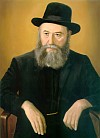20 oF CHeshvan

Rabbi Sholom DovBer Schneersohn (1860–1920)
The “Rebbe Rashab
The fifth rebbe of Chabad-Lubavitch, Rabbi Sholom DovBer Schneersohn, known by the acronym “Rashab,” was born in the town of Lubavitch, in White Russia, on the 20th of the Jewish month of Cheshvan in 1860 (5621 since creation).
Rabbi Sholom DovBer was the third child (and second son) of Rabbi Shmuel of Lubavitch the fourth Chabad rebbe (known as the “Maharash”), and his illustrious wife Rebbezhin Rivkah.
At the young age of twelve, Rabbi Sholom DovBer began transcribing the discourses on Chabad chassidic philosophy that his father delivered—a task usually reserved for distinguished elders. At the age of fifteen he married Rebbezin Sterna Sarah match that had been arranged by his saintly grandfather, Rabbi Menachem Mendel of Lubavitch, prior to his passing in 1866.
Rabbi Shmuel passed away in 1882, at the young age of forty-eight; Rabbi Sholom DovBer was only twenty-one years old when he was orphaned. Though Rabbi Sholom DovBer began delivering original chassidic discourses immediately following his father’s passing—traditionally an act reserved in Chabad for the rebbe—he refused to officially take on the leadership of the movement, in deference to his older brother, Rabbi Shneor Zalman AhAron (known as “Raza”), himself an eminent scholar and worthy leader. Yet Raza, recognizing his younger brother’s holiness and leadership abilities, also refused to accept the position. It was only after Raza moved away from the town of Lubavitch in 1893, eleven years after the passing of their father Rabbi Shmuel, that Rabbi Sholom DovBer officially accepted the mantle of leadership.
Teachings
Famed for his phenomenal mind and analytical treatment of Chabad philosophy, Rabbi Sholom DovBer wrote and delivered some 2,000 chassidic discourses over the thirty-eight years of his leadership. Rabbi Sholom DovBer became known as the “Maimonides of Chabad Chassidism,” for his ability to organize topics in chassidic thought (much as Maimonides codified the Oral Law). He would often recite hemshechim (long series of discourses)—some that lasted for several years!—wherein he comprehensively covered the most abstruse Kabbalistic concepts.
Simultaneously, Rabbi Sholom DovBer took great interest in the simple folk, and said many discourses specifically geared towards those with a limited knowledge of chassidic thought.
Rabbi Sholom DovBer wrote all his discourses prior to saying them, but none of them were published in his lifetime. His son, Rabbi Yosef Yitzchak Schneersohn, the sixth Chabad Rebbe, and Rabbi Menachem Mendel Schneersohn, the seventh Chabad Rebbe, worked on publishing his works. His works, filling tens of volumes, were all published by Kehot Publications, the publishing arm of the Chabad-Lubavitch movement.
Establishes School
In 1897 Rabbi Sholom DovBer established an institution of Jewish learning, a school whose curriculum included the study of Talmudic and legal courses as well as the mystical teachings of Chabad Chassidism. This school also placed special emphasis on prayer: students were encouraged to meditate while praying, to use the opportunity to open their hearts and souls to their Father in heaven.
Rabbi Sholom DovBer named this innovative school “Tomchei Temimim.”
This school produced an army of learned, inspired and devoted disciples, who in the decades to come would be at the forefront of the effort to keep the flames of Judaism alive under Soviet rule and oppression. And these students then carried the torch to the West, where they actively battled the blight of assimilation.
The school was later replicated in countries all over the world. Today, the Tomchei Temimim Lubavitch school system is the largest network of Jewish schools, with branches in dozens of countries on six continents.
Leadership
Rabbi Sholom DovBer took an active role in assisting the Jews oppressed by the czarist government. For example, in 1891, when the Jews were expelled from Moscow, Rabbi Sholom DovBer established a factory for knitting, giving thousands a source of livelihood. He also took a lead in assisting the Jewish soldiers in the Russian army, particularly during the Russo-Japanese War of 1904–05, helping them secure their religious and spiritual needs. Rabbi Sholom DovBer was also in the forefront of the fight against Jewish “reformation” and all the other movements and “isms” whose ideologies ran contrary to traditional Jewish values.
In what would become the prototype for Lubavitch outreach, Rabbi Sholom DovBer sent out emissaries to the largely ignorant “mountain Jews” living in the Russian Caucasian mountains. These emissaries worked on educating the youth, in the interest of creating educated leadership from within the ranks of the local communities.
Rabbi Sholom DovBer is the one who compared the chassid to a lamplighter. “The lamplighter,” he explained, “walks the streets carrying a flame at the end of a pole. He knows that the flame is not his. And he goes from lamp to lamp to set them alight.”
His Passing
Due to the turmoil caused by the First World War, in the autumn of 1915 Rabbi Sholom DovBer moved from the town of Lubavitch to the city of Rostov on the Don River. There he was at the time of the 1917 Bolshevik revolution, and from there he started to wage a war against the Soviet Union’s attempt to Squelch Jewish religious life. After his passing, this effort was continued and expanded by his son.
Rabbi Sholom DovBer passed away in Rostov on the second day of the Jewish month of Nissan, 1920 (5680). Among his final words were: “I am going to heaven; the writings I leave for you . . . ,” a reference to the thousands of manuscripts that he penned.
He was immediately succeeded by his only son, Rabbi Yosef Yizhchack Shneorson.